After being highlighted during the 2002 Winter Olympics in Salt Lake City, Utah’s incredible opportunities for winter sports, including skiing, gained international attention. Skiing is a popular, local activity and considerable component of Utah tourism. With Ski Utah’s acclaimed slogan, “The Greatest Snow on Earth,” area ski resorts aim to attract local, domestic, and international tourists. Of the numerous ski resort options available in Utah, I consider Alta Ski Area to be a Utah treasure due to its unique and superior qualities. Alta Ski Area provides world-class skiing to its visitors due to its distinguishing attributes. It is one of only three remaining ski resorts in the United States that exclusively serves skiers. This creates a truly unique experience, and has earned Alta the title as a “purist’s mountain” (Ski Utah). Skiers are not faced with the common frustrations associated with snowboarders, such as snowboarders obstructing runs by sitting in the center of slopes. Although snowboarders may be unfairly, negatively stereotyped, I personally enjoy the atmosphere of this skier-only resort. I highly recommend Alta to avid skiers visiting Utah for the rare opportunity to ski solely among other skiers. In addition, Alta is recognized as receiving the highest average annual snowfall of any resort in the state, averaging five hundred and sixty inches. With its location at the top of scenic Little Cottonwood Canyon, Alta Ski Area is acknowledged for powder skiing that justifies Utah’s endorsement of “The Greatest Snow on Earth.” The acclaimed, quality snowfall blanketing the resort contributes to Alta’s pristine skiing conditions and natural beauty. This accompanied by Alta’s varied terrain, serves to provide an extraordinary skiing experience for visitors of all abilities, from beginner to advanced. In fact, “Ski Magazine’s Reader Resort Survey ranked Alta #1 for Overall Satisfaction” (Ski Utah). Environmentally conscious tourists will also be pleased with Alta’s commitment to sustainability efforts. The resort is actively seeking and practicing sustainability principles to reduce their carbon footprint. As a business, they emphasize educating their guests, raising awareness among policy makers, advocating for the environment, supporting sustainability related research, and cooperating with organizations that can assist in reducing emissions. Alta satisfies the guidelines for sustainability as outlined by the National Ski Areas Association. By participating in this program, Alta Ski Area further distinguishes itself as a superior ski resort. Alta Ski Area is extremely accessible to tourists around the globe. With the Salt Lake City International Airport only forty-five minutes away, out-of-state and international visitors can take advantage of this convenience. The resort’s proximity to Salt Lake City makes this destination ideal for visitors wishing to incorporate a day or more of skiing into their stay in the Salt Lake Valley. Additionally, the Utah Transit Authority offers bus transportation from Salt Lake City to the resort, making this destination accessible for all visitors, with or without vehicles. Necessary ski equipment can be rented directly at Alta, creating an all-around convenient skiing destination for tourists. Alta is open for skiing November through April from 9 a.m. to 4 p.m. daily. The resort has over one hundred and sixteen runs on twenty-two hundred skiable acres. Adult day passes cost seventy-two dollars; however, multi-day tickets and group tickets are also available. I especially recommend that skiers take advantage of Alta’s “Ski Free after 3 p.m.” program, which offers free skiing for an hour. This provides free access on the Sunnyside Lift, which is mostly comprised of beginner terrain with a few intermediate portions. However, this offer is ideal for beginner skiers, or those wishing to have a taste of Alta’s phenomenal skiing at no cost. With such unique and outstanding qualities, Alta Ski Area is a tourist destination worthy of being world-renowned. Tourists all over the world should take the opportunity to experience the rare atmosphere of a skier-only resort. The pristine snow, diverse terrain, and dedication to environmental sustainability all contribute to Alta’s high level of guest satisfaction. Alta is also accessible to international visitors, which makes this resort an ideal tourist destination. Considering its unique and superior quality, Alta Ski Area is truly a Utah treasure. References and Works Cited: Ski Utah. (2012). Alta Ski Area. Retrieved from http://www.skiutah.com/winter/members/alta_ski_area/resort
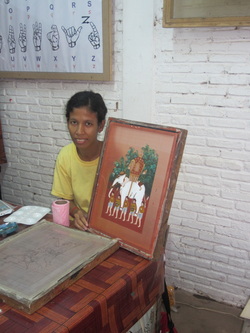 A Deaf artist in Cambodia Purchasing souvenirs while traveling is typically a prime component of a trip, and if tourists wish to make the most responsible and ethical purchases, there are fair trade options available both domestically and abroad. On my recent trip to Cambodia this past summer, I personally supported a fair trade retailer. While touring Phnom Penh, Cambodia, I visited a market which included a shop established by a nonprofit organization called Rehab Craft Cambodia. This organization trains and hires disabled Cambodians as artisans, and also provides these individuals with business training. Since I traveled to Cambodia with an organization called Discovering Deaf Worlds to support the local Deaf community, visiting this retailer was not only an opportunity to interact with Deaf artisans at this shop, but also enabled our tour group to support fair trade as tourists. In addition to selling products in these local Cambodian shops and markets, Rehab Craft Cambodia sells their items through a fair trade, nonprofit company based in the United States called Ten Thousand Villages. Upon returning to the United States following my trip to Cambodia, I visited a Ten Thousand Villages store after realizing their association to Rehab Craft Cambodia. The store offered a wide range of products, and the price tag on every item in the store was labeled with the country in which it was made. As I browsed throughout the store, there were several products made in Cambodia, which elicited my memories and first-hand experience at the Cambodian shop. Although I had previously recognized the significance of supporting fair trade, having the ability to associate specific individuals and faces as beneficiaries from these fair trade purchases created a deeper appreciation and desire to support fair trade. Therefore, I realized the significance of purchasing souvenirs from fair trade stores and vendors internationally, and purchasing cultural items from Ten Thousand Villages stores in the United States. Ten Thousand Villages purchases items from artisans associated with Rehab Craft Cambodia, as well as from organizations and artisans in thirty-seven other countries in Asia, Africa, Latin American, and the Middle East. This fair trade company offers unique handmade items, such as jewelry and decor, by creating a network of “buying relationships in places where skilled artisan partners lack opportunities for stable income” (Ten Thousand Villages). The company, which was originally founded in 1946 and operated out of the founder’s trunk, has since grown to become “one of the world’s largest fair trade organizations” with three hundred and eighty stores and vendors across the United States (Ten Thousand Villages). As a nonprofit company, they are dedicated to supporting and improving the lives of underprivileged individuals in developing countries through their fair trade principles “to meet the ‘triple bottom line‘ of economic, environmental and social sustainability” (Ten Thousand Villages). Due to their commitment to fulfill the cornerstones of fair trade, Ten Thousand Villages has been recognized as “a founding member of the World Fair Trade Organization (WFTO)” (Ten Thousand Villages). The following details how Ten Thousand Villages satisfies the five cornerstones of fair trade. - Fair Working Conditions:Ten Thousand Villages provides fair working conditions, in part by hiring local underemployed and unemployed individuals. By doing so, these individuals have the opportunity to earn fair income to improve their livelihood by selling hand-made products as artisans. As will be discussed in the proceeding section on fair prices, all artisans are compensated fairly for their work and materials, which contributes to their ethical working conditions. In addition, Ten Thousand Villages is a nonprofit organization; therefore any revenue or excess profits received will be maintained within the company “to increase purchases from artisans and to finance the growth of Ten Thousand Villages retail network” (Ten Thousand Villages). This means that Ten Thousand Villages does not make a personal profit, but rather uses any financial resources to further benefit the international artisans around the world. This company is also dedicated to building long-term relationships with artisans and organizations to best benefit the workers. Ten Thousand Villages strives to maintain consistency in regards to the amount of products purchased annually from artisans so that these workers have a dependable income to improve their lives and develop their business. As a testament to their fair working conditions and business practices, Ten Thousand Villages was recognized as “one of the ‘World’s Most Ethical Companies’ by the Ethisphere Institute and Forbes Magazine 2008-2010” (Ten Thousand Villages).
- Fair Prices:Fair pricing is a prime value of this company, and they abide by certain procedures to ensure this practice. The artisans are provided with “up to 50 percent in cash advances when an order is placed, and payment in full when an order is shipped” (Ten Thousand Villages). By doing so, artisans have the ability to buy any necessary equipment and materials without succumbing to debt or relying on high-interest loans. Ten Thousand Villages takes the responsibility of marketing the items in the United States, and because the artisans receive payment prior to sending their products to the warehouse, the artisans’ wages are not impacted by markdown prices. “Ten Thousand Villages buyers and staff” determine fair prices with the artisans “based on the cost of materials, and a fair wage for the production time and skill level required to make each product” (Ten Thousand Villages). Providing fair prices verifies that artisans are ethically compensated for their time and materials cost, allowing them the ability to satisfy their basic needs.
- Integration Into the Local Economy and Regional Development: Ten Thousand Villages is committed to supporting the artisans’ local economies and regional development. By providing employment opportunities for those who may have no other means for income assists in developing the economy and improves the livelihood for individuals in the thirty-eight countries that Ten Thousand Villages supports. Due to the manner in which this company handles business with its artisans, long-term relationship are formed, which establishes a sustainable market that can continue to support these individuals and areas. Through fair trade, these artisans can use their income for food, education, housing, and healthcare, which provides more opportunities to develop their lives and communities. This company also works with the organizations and artisans to determine the best manner in which to construct and design their products to further advance their business. Artisans are encouraged to use local materials to further support the local economy and to design their products that appeals most to customers, namely Americans. Through these practices, the artisans have greater potential to earn more and organizations can hire new artisans in need of employment.
- Fair Trade Partnerships Between All Actors in Tourism: As a company, Ten Thousand Villages is a role model for fair trade (in tourism) which is justified by their Longtime Leadership Award in 2006. They are committed to building fair trade partnerships for all those involved in the tourism industry. Instead of exclusively selling items through Ten Thousand Villages, the organizations and artisans have the opportunity to sell their products in local shops and vendors for international tourists to purchase. However, domestic tourist or even local residents who wish to support fair trade in the United States also have this option through the Ten Thousand Villages sales outlets. Considering the principles which provide the basis for maintaining this fair trade company, the local people of the countries who supply the products clearly benefit from the business. Tourists can also benefit, especially if they are seeking fair trade souvenirs or realize the importance of purchasing fair trade items through one of these Ten Thousand Villages outlets (internationally or in the United States). Ten Thousand Villages also works with the artisans to create products and designs that will most appeal to the customer base, which is largely comprised of American tourists. This will create a greater desire for customers to purchase the fair trade items and allow the local artisans, businesses, and economy to further expand, develop, and benefit.
- Sustainable Resource Use and Environmental Justice: Ten Thousand Villages has demonstrated their commitment to environmental sustainability and justice through their personal business practices as well as encouraging their international artisans to do the same. This company has emphasized the value of minimizing their carbon footprint by maintaining sustainable buildings and practices. Retail outlets are all constructed with “recycled flooring, environmentally safe paints, recycled fixtures and efficient lighting” (Ten Thousand Villages). This company also uses recycled and natural materials whenever possible, which includes printing promotional materials on recycled paper and using their website as an a sustainable alternative to catalogs. To reduce their fuel use and pollution, Ten Thousand Villages relies on sea shipments as much as possible and additionally consolidates their shipments. UPS is then utilized for ground deliveries, which is a sustainable option due to their use of “compressed natural gas, liquefied natural gas, propane, electricity and hydrogen” (Ten Thousand Villages). As a result of their dedication to environmental sustainability, Ten Thousand Villages received with the Co-op America Award for Green Business of the Year in 2005. The artisans abroad are also encouraged to use environmental practices by utilizing natural and recycled materials for the construction of their hand-made products. Artisans use recyclable items such as newspapers, magazines, glass, and sustainable wood (“from farms that replant trees after they are harvested”) to make unique and practical products. In addition, natural materials such as bamboo, water weeds, local raw materials, and natural dies are incorporated into the artisans’ work. Whenever possible, Ten Thousand Villages urges artisans to implement sustainable practices and use environmentally friendly materials.
Although it is possible to purchase inexpensive trinkets while traveling, this is not the most responsible option. Many of these items are mass produced and often are not manufactured by local residents, which does not benefit the local economy. However, tourists should consider making ethical purchases through fair trade vendors and shops. Prior to visiting a destination, tourists should consider researching Ten Thousand Villages’ product providers in the area. By purchasing from these organizations and artisans, tourists can demonstrate their support for fair trade. Domestic tourists can also support fair trade by purchasing items from Ten Thousand Villages to support artisans abroad. (2012). Ten Thousand Villages. Retrieved from http://tenthousandvillages.com/
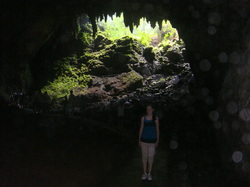 Traci in a cave in Puerto Rico My recent international trips have exposed me to various destinations around the world, including Puerto Rico, Japan, and Cambodia and Thailand. I visited these locations over the past three consecutive summers, and my rationale for traveling to each of these areas involved various motivations. The trip to Puerto Rico was a family vacation, and the purpose of this trip was to visit family and gain a deeper appreciation for my heritage. My grandmother was born and raised in Puerto Rico, and much of my family resides in Puerto Rico, so this vacation was an opportunity to connect with family and explore the island for the first time. Visiting Japan was a trip I made independently and spontaneously; I literally purchased my plane ticket the morning I departed. My aunt, uncle, and cousins lived in Tokyo for several years, so visiting them was a contributing factor in taking this trip. However, my main motivation in traveling to Japan was to escape my daily life and frustrations. This vacation was therapeutic and provided me the opportunity to clear my head and find my inner-self while independently exploring Tokyo. Finally, I traveled to Cambodia and Thailand this past summer with an organization called Discovering Deaf Worlds, to support Deaf advocacy organizations and members of the local Deaf communities. This provided me exposure to unfamiliar and fascinating countries, while supporting a cause that I am truly passionate about. This tour allowed me to connect with the local people, and gain a deeper understanding and appreciation of the lives they have lived.
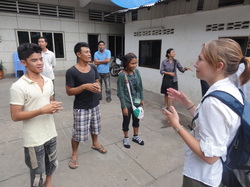 Traci signing with Deaf Cambodians in Phnom Penh When I travel, I seek unique experiences and opportunities that are contrary to what I would experience in my daily life. I am an allocentric tourist, so I actively pursue travel destinations that allow me to become immersed in foreign languages, cultures, foods, and history. Gaining an authentic experience is my priority, and therefore I avoid areas dominated by tourists whenever possible. During my travel experiences, my desire is to connect with the local people, whether or not we speak the same language, and observe first-hand how they live. Personally, I am fascinated with the local history and learning about various components that have shaped the lives of the local people. By interacting with the native people, I have gained new and diverse perspectives, which has broadened my thinking and acceptance of different ideas, people, and cultures. My open-minded nature, formed by my international experiences, has also influenced me to fully experience and immerse myself in the culture of the country that I am visiting. For example, this past summer when I visited Cambodia, I sampled many unique foods, including chicken feet, crickets, and snake. Although I would not ordinarily each such foods, I gained a richer experience by eating the local cuisine. In my option, it is important to take risks and live out-side of my comfort zone when I travel to fully experience the host country and enrich my life.
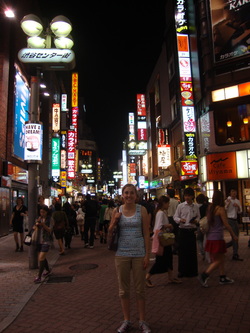 Traci on the streets of Tokyo, Japan Aside from traveling, three activities that I am passionate about are skiing, walking and hiking, and sign language. Since learning how to ski at the age of five, I have been addicted to the thrill that skiing provides. Personally, I find skiing to be appealing because it can be both a peaceful and adrenaline-induced experience. While engaging in this activity, I can enjoy the natural beauty of the mountains as I gracefully slalom through the powdery snow. In addition, I enjoy walking and hiking, which was initiated during my childhood due to my upbringing in an active family in Colorado. I especially enjoy walking and hiking when I travel because I have found it to be the most effective manner to observe and immerse myself in many countries or areas. For example, I experienced El Yunque (a rainforest in Puerto Rico) by foot, which provided spectacular views that were only visible along the hiking trails. My tour of Tokyo also included a tremendous amount of walking because it is an extremely walk-friendly city (with the assisted use of public transportation). While walking the streets of Tokyo, I discovered many areas and attractions that I might have otherwise missed due to the city’s expansive, yet compacted nature. Finally, walking and hiking rural areas of Cambodia provided me with the opportunity to connect with the local people who were harvesting rice-fields in Kampot. Exploring various areas in this manner is such a personal way to connect to the area, and provides a more gratifying experience. Lastly, I am particularly passionate about sign language and engaging with the Deaf community. In the future, my goal is to combine my passion for both sign language and travel to provide international tours for members of the Deaf community. Although this is not particularly a physical activity, it is a strong passion and component I wish to include within my travels.
Since these activities are strong, personal passions, it would be ideal to incorporate them into future trips. Although I have not traveled internationally for the purpose skiing, this is a realistic endeavor to consider. Many destinations around the world are recognized for their ski resorts, and are also countries that I would be interested in visiting or revisiting. Such renowned options include Chile, Canada (British Columbia and Vancouver), Japan, New Zealand, and Europe including Switzerland, Austria, France, and Italy. These countries would not only fulfill my desire to ski, but would also offer essential elements that I seek while traveling, such as foreign cultures, languages, history, etc. In addition, these destinations likely offer walking tours and trails for hiking to fulfill this passion as well during my visit. It is also possible that I could either arrange to travel to these countries with members of the Deaf community, or even connect with members of the local Deaf community in these areas. By selecting one of these destinations, it would be achievable to integrate all of my passions into an international experience that would provide optimal, personal satisfaction to further enrich my life through travel.
Peru Eco Adventure & Cultural Trips is a travel company located in Cusco, Peru. This travel company does not appear to be a member of the International Ecotourism Society, but does claim to be an eco-travel provider. Several tour options are available through this company including rafting, trekking, mountain biking, and tours of the Manu-Jungle, Lake Titicaca, and the Inca Trail. These tours vary in duration and location within Peru, providing a wide-range of tour options. Peru Eco Adventure & Cultural Trips was founded by a Peruvian native, Alvaro Sabogal, who actually served as a guide for my parents when they hiked the Inca Trail to Macchu Picchu ten years ago. He has worked in the field for sixteen years, possesses several tourism related degrees, and is currently completing his degree in Sustainable Tourism and Ecology. Alvaro prides himself on implementing sustainable tourism practices, especially in areas such as the environment, culture, history, nature, and adventure. His staff is also well trained in providing ecological adventures. This company supports the local community by hiring local staff members and supporting local businesses, markets, and people during their tours. According to their website, Peru Eco Adventure & Cultural Trips is committed to sustainable tourism. There is a portion of the website that is dedicated to describing their sustainable tourism practices, in addition to their sustainable projects. From the information gathered from their website, it appears that this company follows various ecotourism fundamentals as outlined by Pamela Wight. The most predominate fundamentals addressed by this company are, “It should provide long-term benefits - to the resource, to the local community, and to industry (benefits may be conservation, scientific, social, cultural, or economic)” and “It should involve acceptance of the resource on its own terms, and in recognition of its limits, which involves supply-oriented management” (Wight, p.3). Despite the focus on these two specific fundamentals, the following information contains elements that overlaps other ecotourism fundamentals as well. The website emphasizes, on several occasions, this company’s dedication to long-term benefits for the resource, local community, and industry. According to the website, by participating in one of their tours, “You will be supporting our cause: To protect and preserve both the natural environment and landscape of this country, as well as the traditional cultural heritage and future welfare of its local inhabitants” (“Peru Eco Adventure”). This company continuously refers to their dedication to not only preserve the natural environment of Peru, but to also protect and positively impact the local heritage, culture, and people. “...[O]ur tourist activities are pointed toward recovering and revitalizing cultural traditions through human interaction in harmony with social development” (“Peru Eco Adventure”). In addition to numerous projects this company has implemented to protect the natural environment (which will be discussed in further detail), they clearly promote projects that benefit the local people. These include programs to protect and provide training programs in the areas of folk art, handicraft activities, agriculture, in addition to providing local education and health care. This company also helps to educate the local population about the environmental condition, and the importance of recycling and engaging in biodegradable activities. Peru Eco Adventure & Cultural Trips also notes that they also “take special care that our porters and staff receive the best conditions and treatment... and that the women of the community, who are gifted weaver and crafters, are fairly and generously paid and remunerated for their work” (“Peru Eco Adventure”). Such information provided on their website indicates this tour company’s work towards long-term benefits for the resource, local community, and industry. This Peruvian company has also accepted the resource on its own terms, recognized its limits, and is promoting projects which involve supply-oriented management. “In South America, and Peru in particular, we are poignantly aware that our once seemingly endless natural resources are dwindling at an ever-increasing rate. It is of the essence to act now - first and fast- before the ‘point of no return’ is reached” (“Peru Eco Adventure”). From this statement, it is clear that this tour company recognizes the environment’s limits and has identified that action is necessary. Their dedication to this cause is demonstrated by their projects to raise environmental awareness and concern, to influence action to protect and conserve these areas. In this portion of their website, various environmental issues are addressed. A large issue that Peru is currently facing is deforestation, which includes logging and slash and burn techniques. These practices are rapidly depleting the forest and causing other adverse effects such as accelerated erosion, a decrease in wildlife, and a decrease in oxygen that is created from these forests. Scarcity and pollution of water is also another large issue facing Peru. With contributing factors such as global warming and receding glaciers, water is becoming more scarce, but unfortunately, much of the rivers and water sources are becoming polluted instead of conserved. Although these are large issues facing this country, Peru Eco Adventure & Cultural Trips is implementing programs to assist in these dire situations. They are making a stand to stop deforestation and support reforestation projects. In addition, this company is working with authorities and the local population to stop pollution to protect their rivers and water sources. Since this company offers rafting and kayaking tours down the Vilcanota River, this effort is also essential in maintaining their business operations, in addition to the environmental benefits it provides. This company is making an effort to address these issues so that it may be protected for future generations. Despite not being a member of the International Ecotourism Society, it appears that Peru Eco Adventure & Cultural Trips has clear intentions to fulfill their claim as being an ecotourism provider. Not only does “eco” appear in the name of their company, but portions of their website and tours are dedicated to sustainable tourism and sustainable projects that protect the environment, culture, and people of Peru. Machete Tours is an eco-tourism operator based in Cuzco, Peru. This company is a recent member of the International Ecotourism Society, as of 2012. They provide a wide variety of “cultural, wilderness and activity tours in South America” such as hiking (including the Inca Trail), tours of Machu Picchu, Peru, Bolivia, and Ecuador, mountain expeditions, climbing, Amazon River cruises, rafting, jungle expeditions, off-road programs, and beach vacations (“Machete Tours”). Machete Tours has been providing tours for eleven years, and focuses on exposing tourists to the natural beauty and diverse culture of South America. Since Machete Tours is a member of the International Ecotourism Society, they have demonstrated that they fulfill the standards to be recognized as an ecotourism provider. The two most prevalent ecotourism fundamentals demonstrated by this company are, “It should provide long-term benefits - to the resource, to the local community, and to industry (benefits may be conservation, scientific, social, cultural, or economic)” and “It should provide first-hand, participatory, and enlightening experiences” (Wight, p.3). From information provided on their website, Machete Tours demonstrates that they have established long-term benefits for the resource, local community, and industry. They assert that “travel services are monitored for good practices and environmental sustainability - maintaining maximum benefit for both local people, clients and the surrounding regions” (“Machete Tours”). Included within this commitment to sustainability is sharing the income generated from tourists with the local communities and protecting traditional cultures in the area. The website also describes a project which benefits Peruvian school-aged children. This program, called “The Hans Christiansen Library Project” provides books (and other supplies and financial assistance) for school-children that live in remote areas of Peru. Since these children do not have access to such resources, Machete Tours encourages their tour participants to contribute to this cause (by donating books, supplies, or financial assistance) during their visit to positively impact the local community. Machete Tours is also dedicated to protecting the natural environment. They began their ecotoursim operations in the Amazon Jungle “in and around the incredible UNESCO World Heritage Site of the Manu Biosphere Reserve” (“Machete Tours”). During their tours, this company is determined to provide “an incentive to keep the rainforest and its wildlife in a pristine state - a truly long-term vision that contrasts against logging and mining operations that provide short term financial benefits but long-term destruction and poverty” (“Machete Tours”). Clearly, this ecotourism provider considers the necessary long-term benefits for the local people and environment in their operation. Machete Tours also provides first-hand, participatory, and enlightening experiences. This practice is quite apparent after visiting their website, which contains a quote at the top of the page stating, “We believe that love and understanding for nature comes through living amidst it” (“Machete Tours”). The goal of their tours is to provide exposure to these areas that will positively alter the manner in which tourists view these areas, and the environment as a whole. Peru is one of the most bio-diverse countries in the world with deserts, rain-forests, icy mountains, and volcanos. With such diverse, natural beauty, “Machete Tours can guarantee ethical adventures that are both rich and inspiring” (“Machete Tours”). Touring any of these natural environments is capable of providing an enlightening experience for tourists. During their tours, this ecotourism company also asks their travelers to become conscious of the amount of water, electricity, and materials/resources they use during their stay, as shortages can be a common occurrence in this area. Tourists that travel in such a manner and have incredible experiences and exposure to nature will come away with a great appreciation for the natural environment. Based on the information provided by their website, Machete Tours’ classification as an ecotourism provider and member of the International Ecotourism Society is justified. The manner in which they facilitate their tours coincides with ecotourism fundamentals and is in the best interest of the local environment and community. References and Works Cited (n.d.). Machete Tours: Peruvian Travel Ecotourism. Retrieved from http:// www.machetetours.com/ (2012). Peru EcoAdventure & Cultural Trips. Retrieved from http:// www.cuscomachupicchu.com/ (1990-2012). The International Ecotourism Society. Retrieved from http://www.ecotourism.org/ Wight, P. (1993). Ecotourism: Ethics or Eco-Sell? In Journal of Travel Research. Retrieved from https://learn-uu.uen.org/courses/103289/files/8260235/
Although tourism industries and providers are demonstrating environmental concern and implementing sustainable practices, tourists themselves must be reeducated to make the most meaningful impact. With large numbers of tourists visiting destinations all over the world, the damage to the environment can be tremendous. However, there are steps that all tourists can take to travel more sustainably and responsibly. Tourists have the ability to influence the industry by selecting and supporting sustainable providers and options, which demands the industry to accommodate environmental travelers. Through reeducation, an increasing number of tourists will invest in sustainable tourism providers and practices to protect the environment.
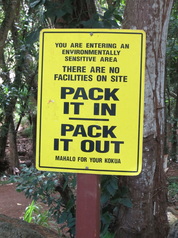 An environmental sign in Hawaii
Reeducating is more than simply posting signs and distributing brochures. This sign (pictured on the left) was posted on a trail along the Hana Highway in Maui, Hawaii. Although this sends a positive environmental message, this is often not enough to influence tourist behavior. Unfortunately, it is a common sight to see garbage littering the trails right next to signs such as this one. Signs (or other written information) can be easily ignored and can only make so much of an impact. Therefore, signs act more as visual reminders for responsible actions, but further action must be taken to truly impact tourist behavior.
Face-to-face and hands-on re-educational experiences are considerably more effective in positively shaping the environmental-conscious behavior of tourists. Resources such as guided tours, interpreters, and visitor centers are invaluable to this effort. When traveling, tourists are typically open-minded to learning and are eager to gain more information regarding the destination they are visiting. This provides the prime opportunity to reeducate tourists not only about the history and attributes of the area, but also how it is being impacted environmentally. The reeducation process also includes explaining the actions that can be taken to best protect the environment, and illustrates why such actions are necessary.
The reeducation process can also further elicit emotions of attachment and may influence a person to travel sustainably. Environmental “educators” (such as guides and interpreters) can further depict the sheer, natural beauty of an area, and describe the devastating effects if environmentally-friendly measures are not taken. Tourists may gain a deeper emotional attachment to a particular area (or the environment as a whole) and obtain a stronger commitment to protect it. These tourists will want to protect the area for personal reasons, and for the enjoyment of future generations. This is quite powerful in altering behavior, and will assist in influencing them to make future sustainable choices and act as advocates for protecting areas from environmental damage. These tourists may even influence others to travel sustainably because of their re-educational experience.
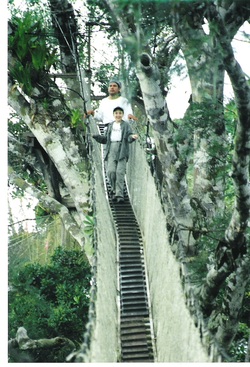 Traci on the Amazon Canopy Walk-way Personally, I was most impacted by my re-educational experience in the Amazon Jungle in Peru. I visited this destination when I was only twelve years old, yet it was an impressionable experience that opened my eyes to the concept of sustainable tourism. The entire trip was an environmentally educational experience, and impacted my view on the environment and the importance of sustainable tourism.
The exposure to the vast rainforest was an indescribable experience. I was surrounded by massive trees and plants that seemed to continue endlessly in each direction. There was such an incredible range of wildlife, including peaceful and intimidating encounters. During this trip, I had the unique opportunity to walk along the canopy walk-way which provided a breath-taking view of the jungle’s canopy and all of its beauty. These sights and experiences contributed to a personal passion and emotional attachment to this area, but these feelings were further influenced by the reeducation I received.
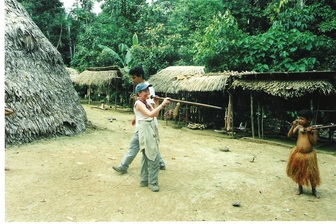 Traci using a blowgun in a Peruvian village Our native guide, Raul, provided us with fascinating information that illustrated his knowledge and passion for the natural home where he grew up. The education he provided regarding the jungle has left a lasting impression on the manner in which I view and appreciate the environment. Unfortunately, during this trip, I witnessed the destruction that logging was causing, and Raul explained how much the jungle was being damaged. It was depressing to see, but it strongly influenced me to want to protect the jungle from such destruction. My family and I also had the opportunity to visit Raul’s village, and it was fascinating to see how the native people lived off of the land, without destroying it. Instead of disregarding the environment, they demonstrated how to live in a sustainable manner. I began to realize that if these native people could live sustainably, then as tourists, there is a moral responsibility to travel sustainably.
The travel provider, Amazon Explorama Lodges, also provided as a wonderful example for implementing sustainable tourism practices. Their lodges reflected the native huts of the area, which included minimal modern convinces. This made the experience more authentic, protected the integrity of the area, and reduced the environmental damage that building a resort would have caused. In addition, all of the guides were local natives. This meant that they were experts of the area, and this company was supporting the local economy. In general, this travel provider made every effort to make the minimum environmental impact.
Since taking this trip and receiving this reeducation, I have put more consideration into how I travel. I now seek sustainable travel providers whenever possible and encourage others to do the same. If tourists can all be reeducated when they travel, tourists and the travel industry as a whole, can leave less of a damaging impact on the environment, so that we may all have the opportunity to enjoy it.
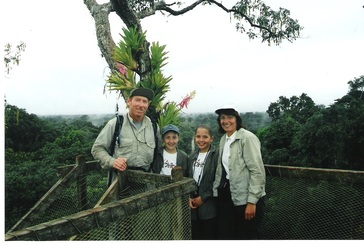 Traci and her family in the Amazon Jungle
When considering the “R Words,” as discussed by Middleton, “Reuse” is a concept and sustainable practice of significance. According to an online dictionary source, reuse is defined as “To use again, especially after salvaging or special treatment or processing” (The Free Dictionary). When employed in various manners by the tourism industry, reuse is a tremendous tool that can result in substantial environmental benefits. Such benefits may explain and justify its inclusion within the infamous “Three Rs: Reduce, Reuse, Recycle,” in addition to Middleton’s “Ten Rs.” As stated by Middleton, “Individually the re-use savings may appear relatively trivial, but collectively over twelve months can produce quantifiable benefits if a monitoring system is in place” (pg. 136-137). Small and simple actions can have desirable benefits not only for the environment, but also for all of those involved within the tourism industry including tourism businesses/providers, tourists, and members of the local community.
Various reuse methods are utilized within the tourism industry, and hotel operations specifically provide as an ideal example of various manners in which to reuse. When implemented, these result in environmental benefits and are often more cost-effective as well. A common practice in hotels is providing guests with the option to reuse their towels and sheets instead of requesting them to be washed daily. If guests select this sustainable option, the amount of water and detergent use can be greatly minimized. Additionally, hotels may provide reusable items as apposed to disposable options, which includes sustainable alternatives such as glass cups and ceramic mugs, and soap dispensers instead of miniature bottles. These items can be continuously reused by guests and therefore considerably reduces waste. Hotels that provide food services should elect to utilize reusable items such as cloth napkins, ceramic plates and silverware, and hotel staff may also further implement this sustainable practice by utilizing reusable containers and bags for laundry and other hotel functions. Often hotels also reuse old furniture by either refurbishing it or donating it, instead of simply disposing of it. The hospitality industry demonstrates these reuse principles in hotels throughout the world, which can make a strong impact in protecting the environment.
Other examples of reuse are demonstrated in various tourist destinations all over the world. Countries such as Jordan and China are enacting wastewater reuse programs for agricultural and landscaping purposes, to reduce water use and waste. Instead of simply disposing of their old airline blankets, British Airways donates their old blankets to elephant orphanages in Kenya and Zambia. Many resorts throughout the world offer rentals, such as snorkeling gear, for the repeated use of their guests. This practice can minimize the need for new equipment, which saves resources and reduces the amount of equipment that is unnecessarily disposed of at the conclusion of a vacation.
The concept of reuse will also be demonstrated in regards to the upcoming Olympics in London, England. The Olympics attract a considerable amount of tourists, therefore large structures are built to host these tourists and events. In past cases, the stadiums and facilities remain unused after the Olympics, despite the considerable cost to the local communities to build these structures. However, following the London Olympics later this year, the Olympic stadium and the Olympic Aquatic Centre will be repurposed and reused by the local community. Both facilities have been built so that additional seating can be removed at the conclusion of the Olympic Games; after which point, the Olympic stadium will be converted into a soccer stadium, and the Olympic Aquatic Centre will be repurposed for the use of the community. In this instance, reuse provides benefits for all facets of the tourism industry, especially since the community will benefit in addition to tourists and travel providers.
Due to the tourism industry’s growing concern for the environment, I have encountered methods of reuse throughout my personal travel experiences. About ten years ago, I had the unique opportunity to travel with my family to the Amazon Jungle in Peru. Overall, this trip included numerous sustainable components; however, there is a specific example that comes to mind in regards to reuse. During our stay, the lodge provided drinking water stations, which included purified rainwater with reusable glass cups. Rainwater was additionally utilized to provide water for the showers at the lodge. This made for a chilly shower, but this reused water was refreshing after hiking in the excessive heat of the Amazon.
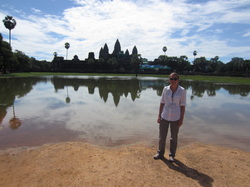 Traci at Angkor Wat in Siem Reap, Cambodia This past summer, I also had the amazing opportunity to travel to Cambodia, which was an incredible tourism experience that also included elements of reuse. The most fascinating aspect of my trip was visiting the breath-taking temples of Angkor Wat; one of the Man-Made Wonders of the World. During my visit, portions of the temple were in the process of being restored; however, I was pleased to learn that the original stone was being reused as much as possible for the restoration. This is important not only to protect the environment (because transporting new stone would be quite damaging), but also to protect the integrity of the temple as a heritage site. In such a case, reuse is by far the best course of action for protecting this stunning architectural treasure.
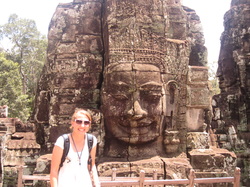 Traci in Angkor Thom in Siem Reap, Cambodia I was also fascinated to learn that reuse has been an ancient practice within Angkor Wat (and surrounding temples), architecturally speaking. When first built in the early twelfth century AD, it was intended “as a Hindu capital for the Khmer Empire” (Richter, 2009). However, as Buddhism began to grow in popularity at the end of the twelfth century, Angkor Wat became a place of Buddhist worship. The temple then reflected elements of both the original Hindu influence as well as the Buddhist religion. Again in the mid-thirteenth century, the Hindu religion was re-established in the Khmer Empire, altering the focus of the structures. During this period, some of the faces of various Buddhas, which had been added in Angkor Wat and nearby Angkor temples, were temporarily removed. However, this was a brief period, and by the end of the thirteenth century, Buddhism was reinstated as the main religion until the end of the Khmer Empire (Richter, 2009).
Instead of building an entirely new temple with each change in religion, people of the Khmer Empire reused the existing temples by repurposing them as the religious focus changed. In those times, building any type of structure was a tremendous feat; therefore, the people practiced the concept of reuse. This day in age, building a new structure is not such an ordeal. With this reduced effort, many do not consider the option of reuse, or the consequences of building a new structure entirely. It appears that we could all learn a lesson from the past, to protect our environment for the future.
I believe that it is essential to practice reuse within the tourism industry. It includes simple actions that can have a tremendous, positive impact on the environment that we can all benefit from. We can each contribute to achieve these benefits, whether we are tourist providers implementing reuse policies, or tourists who select environmentally friendly options. Personally, I am passionate about traveling and therefore support and encourage the travel industry to implement such sustainable measures to protect our world for future generations to come. Works Cited Ashley M. Richter. (2009, September 8). Recycling Monuments: The Hinduism/Buddhism Switch at Angkor. Retrieved from http://archive.cyark.org/recycling-monuments-the-hinduismbuddhism-switch-at-angkor-blog Middleton, V., & Hawkins, R. (n.d.). The ‘R Word’ guide to corporate action on sustainability. In Sustainable Tourism: A Marketing Perspective (chapter 11). Retrieved from https://learn-uu.uen.org/courses/103289/files/8249307 Reuse. 2012. The Free Dictionary online. Retrieved from http://www.thefreedictionary.com/reuse References Ashley M. Richter. (2009, September 8). Recycling Monuments: The Hinduism/Buddhism Switch at Angkor. Retrieved from http://archive.cyark.org/recycling-monuments-the-hinduismbuddhism-switch-at-angkor-blog (2009). Environment – waste. Retrieved from http://www.britishairways.com/travel/csr-waste/public/en_gb (2012). Making Every Drop Count. Retrieved from http://cdmsmith.com/en-US/Solutions/Water/Making-Every-Drop-Count.aspx (2011, September 25). London 2012 Olympics: Reduce, Reuse, Recycle. Retrieved from http://hospitalityandtravelnews.blogspot.com/2011/09/london-2012-olympics-reduce-reuse.html (2012). Sustainable Solutions for Green Hotels. Retrieved from http://globalstewards.org/hotel.htm
|




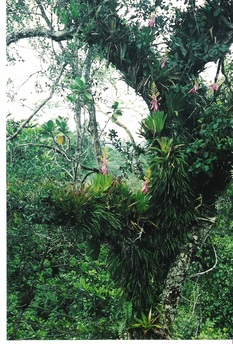






 RSS Feed
RSS Feed